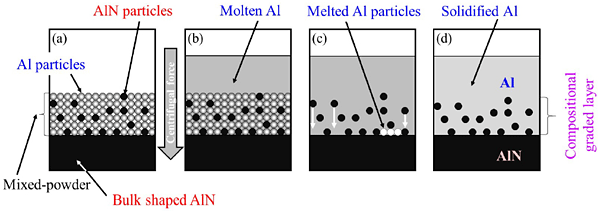Aluminum nitride (AlN) is a popular ceramic material for its high hardness (1400 HV) and wear resistance as well as its high thermal conductivity (320 W/mK, theoretically at room temperature (RT)) and electric resistivity. Since high heat dissipation is required on the boards, joining boards of AlN and Al are used. It is reported that AlN may be wet by molten Al without any reaction at AlN/Al interface. However, conventional laminated composites consisting of ceramics and metals have a problem that delamination often occurs at the joining interface due to thermal stresses by the difference of the thermal expansion coefficient. In order to solve this problem, the concept of ceramics/metal functionally graded materials (FGMs) can be applied, where the FGMs are materials with gradual changes in compositions and/or microstructures with positions. In this study, a novel joining technique based on the centrifugal mixed-powder method (CMPM) with graded structures is proposed. The CMPM is proposed by Watanabe et al. As a first step of the process, a mixed-powder of ceramic particles and matrix metal particles is inserted into a spinning mold. Then, molten matrix metal is poured into the spinning mold with the mixed-powder. As a result, the molten matrix metal penetrates into the space between the mixed-powder by the centrifugal force. At the same time, matrix metal particles in the mixed-powder are melted by the heat from the molten matrix metal. Finally, metal-based FGMs with ceramics particles distributed at one side can be obtained. The obtained FGMs could be used as the compositional graded layer to join the ceramics and metals. In this study, joining of ceramics and metals with compositional graded layers made by CMPM is studied. Experiments are done for joining of AlN and Al, and micromechanics-based analysis is conducted to understand the thermal stress relaxation due to presence of the compositional graded layers.
Schematic diagram of joining by the CMPM is shown in Fig. 1. The bulk-shaped AlN fabricated by a spark plasma sintering (SPS) and the mixed-powder of AlN particles with 99 % purity and Al particles with 99.9 % purity (106 to 180 µm in diameter) were inserted into a preheated spinning mold at 600 °C, as shown in Fig. 1 (a). The diameter of AlN particles is 75-150 µm for Sample 2, Sample 3 and Sample 4 and 150-212 µm for Sample 5. The volume fraction of AlN particles in mixed-powder are 20 % for Sample 3 and 30 % for other samples. The thicknesses of mixed-powder are 2 mm for Sample 2 and Sample 3, and 4 mm for Sample 4 and Sample 5. Then the molten Al at 1200 °C was poured into the spinning mold with the bulk-shaped AlN and the mixed-powder, as shown in Fig. 1 (b). Here, the applied centrifugal force was G number of 80, where the G number is the centrifugal force in units of gravity. As a result, the molten Al penetrates into the spaces between the mixed-powder by the centrifugal force. At the same time, the Al particles can be melted by the heat from the molten Al, as shown in Fig. 1 (c). Eventually, the AlN particles are dispersed in the Al matrix at the interface, where the zone is denoted as compositional graded layer, as shown in Fig. 1 (d). Casting was carried out under the vacuum condition in a vacuum centrifugal casting machine. To reveal the effect of thermal stress relaxation by the compositional graded layer, the CMPM with only Al particles (without compositional graded layer) is also studied, and it is denoted as Sample 1. After casting, all the samples were cooled in the furnace.
Microstructures of AlN/ Al interfaces in Sample 2 and Sample 3 are shown in Figs. 2 (a) and (b), where volume fractions of AlN particles in mixed-powder are 30 % and 20 %, respectively. It is seen from Fig. 2 that AlN particles are dispersed in the compositional graded layers, and AlN and Al are successfully joined without any cracks at the interface. This is because the molten Al could penetrate into the mixed-powder with small difference in particle sizes.
Microstructures of the compositional graded layer of Sample 2 and Sample 3 are shown in Figs. 2 (c) and (d), respectively. These figures reveal that no reaction and no crack can be found at the interface between the AlN particles and Al matrix. The thickness of the compositional graded layer in both samples was about 3 mm. Moreover, the total volume fractions of AlN particles in the Specimen 2 and Specimen 3 are about 30 % and 20 %, respectively, which indicates that the volume fraction in the compositional graded layer is controllable by the initial composition of the mixed-powder.

